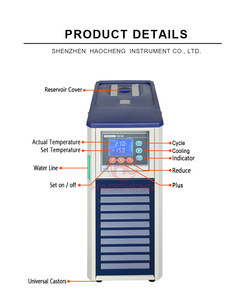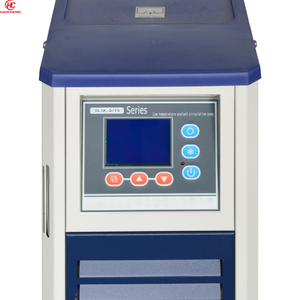
All categories
Featured selections
Trade Assurance
Buyer Central
Help Center
Get the app
Become a supplier

(178 products available)





















The high temperature oil circulation mold temperature controller suppliers is an essential component in the realm of plastic and rubber processing machinery, specifically designed to regulate the temperature of molds used in the manufacturing process. This regulation is crucial to ensure the quality and consistency of molded products, as the temperature directly affects the viscosity and flow of the materials. By maintaining an optimal temperature, the high temperature oil circulation mold temperature controller suppliers helps achieve precise dimensional stability and surface finish, reducing defects and enhancing productivity. These controllers are indispensable for industries that rely on high-quality molding, such as automotive, electronics, and consumer goods manufacturing.
There are various types of high temperature oil circulation mold temperature controller suppliers available to cater to different industrial needs. The most common types include water-based and oil-based controllers. Water-based high temperature oil circulation mold temperature controller suppliers are preferred for their efficiency and cost-effectiveness, suitable for applications requiring temperatures below 100°C. Oil-based controllers, on the other hand, are used for higher temperature requirements, often exceeding 200°C, making them ideal for engineering plastics and rubber processing. Each type offers specific advantages and is tailored to meet the demands of particular manufacturing processes. Understanding these types helps in selecting the appropriate controller that aligns with the production requirements and operational conditions.
The primary function of a high temperature oil circulation mold temperature controller suppliers is to regulate and maintain the temperature of molds during the manufacturing process. These controllers are equipped with advanced features such as digital displays, programmable settings, and alarms for temperature deviations. The digital display allows operators to monitor real-time temperature, ensuring precise control over the molding process. Programmable settings enable customization according to specific material and product requirements, enhancing flexibility in production. Additionally, alarms for temperature deviations serve as a safeguard, alerting operators to potential issues that could affect product quality. These features collectively contribute to the efficiency and reliability of high temperature oil circulation mold temperature controller suppliers in industrial applications.
The construction of a high temperature oil circulation mold temperature controller suppliers involves the use of high-quality materials designed to withstand the rigors of industrial environments. Common materials include stainless steel, which provides durability and resistance to corrosion, and advanced polymers for insulation and protection. The internal components, such as pumps and heaters, are crafted from precision-engineered materials to ensure optimal performance and longevity. These controllers may also include additives like thermal fluids for enhanced heat transfer capabilities. The choice of materials directly impacts the efficiency, durability, and maintenance needs of the high temperature oil circulation mold temperature controller suppliers, making it crucial to select controllers with robust construction for demanding applications.
Effective use of high temperature oil circulation mold temperature controller suppliers involves understanding the specific requirements of the manufacturing process and configuring the controller accordingly. Operators must ensure that the temperature settings are appropriate for the materials being processed to avoid issues such as warping or incomplete curing. Regular maintenance, including checking fluid levels and inspecting components, is essential to maintain the performance and longevity of the controller. Additionally, integrating high temperature oil circulation mold temperature controller suppliers with automated systems can enhance precision and efficiency, reducing manual intervention and optimizing production workflows. Training personnel in the operation and maintenance of these controllers further ensures consistent product quality and operational efficiency.
Choosing the right high temperature oil circulation mold temperature controller suppliers for your plastic and rubber processing needs requires careful consideration of several factors. The first step is to assess the temperature range necessary for your specific application. Different materials and products may require different temperature settings, influencing whether a water-based or oil-based controller is more suitable. Additionally, the size and complexity of the molds in use should be evaluated, as larger or more intricate molds might demand more robust temperature control solutions. Compatibility with existing machinery and systems is also crucial to ensure seamless integration and efficiency in production.
Another important consideration is the energy efficiency of the high temperature oil circulation mold temperature controller suppliers. Energy-efficient models can significantly reduce operational costs over time, making them a sound investment. Look for controllers with advanced features such as variable speed pumps and intelligent control systems that optimize energy consumption without compromising performance. Reliability and ease of maintenance are also key factors; choosing a controller with durable construction and readily available spare parts can minimize downtime and ensure consistent productivity. Evaluating these aspects carefully will help in selecting a high temperature oil circulation mold temperature controller suppliers that aligns with your manufacturing goals and operational constraints.
The cooling method is a critical factor in choosing a high temperature oil circulation mold temperature controller suppliers. Water-based controllers are generally more efficient for applications requiring moderate temperatures, while oil-based controllers are suited for higher temperature needs. The choice between these methods should align with the specific temperature requirements and the thermal properties of the materials being processed. Additionally, the cooling method impacts the controller's efficiency and operational costs, so it's essential to consider the long-term implications of this choice.
Ensuring the longevity of your high temperature oil circulation mold temperature controller suppliers involves regular maintenance and proper usage. Regularly check fluid levels and inspect components for wear and tear. Cleaning the system and replacing filters as needed can prevent blockages and ensure optimal performance. Training personnel on the correct operation and maintenance procedures is also crucial, as improper handling can lead to premature wear or damage. Integrating the controller with automated systems can further enhance precision and reduce manual errors, contributing to its longevity.
Common features to look for in a high temperature oil circulation mold temperature controller suppliers include digital displays for real-time monitoring, programmable settings for customization, and alarms for temperature deviations. These features enhance control over the molding process and provide flexibility to adapt to different materials and product requirements. Additionally, advanced models may offer remote monitoring capabilities, allowing operators to manage the system from a distance, which can be particularly beneficial in large-scale operations. Evaluating these features can help in choosing a controller that meets your specific needs.
Environmental considerations are increasingly important when selecting a high temperature oil circulation mold temperature controller suppliers. Energy-efficient models can reduce the carbon footprint of your operations, and selecting controllers with eco-friendly thermal fluids can minimize environmental impact. Additionally, opting for durable materials that reduce the need for frequent replacements can contribute to sustainability. Understanding the environmental impact of your choices and seeking controllers that align with sustainable practices can enhance your commitment to responsible manufacturing.
Integrating a new high temperature oil circulation mold temperature controller suppliers into existing systems can present challenges such as compatibility issues with current machinery or software. It's crucial to ensure that the controller can communicate effectively with other equipment to avoid disruptions in the production process. Calibration and testing may be required to align the new system with existing operations. Additionally, training personnel on the new technology is essential to ensure they can operate and maintain the system effectively. Addressing these challenges proactively can facilitate a smooth transition and enhance overall productivity.